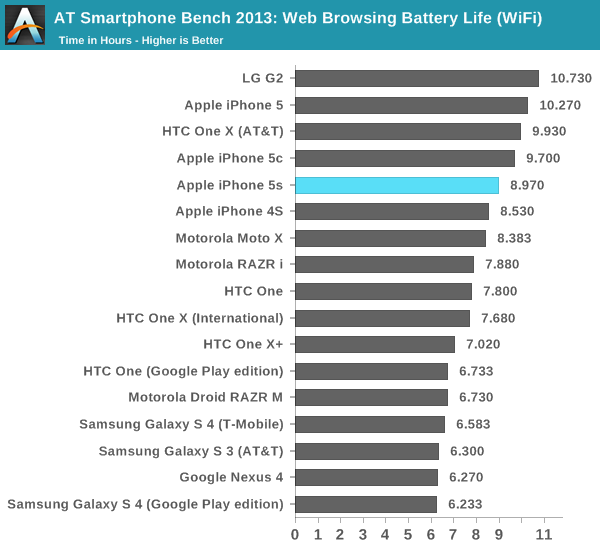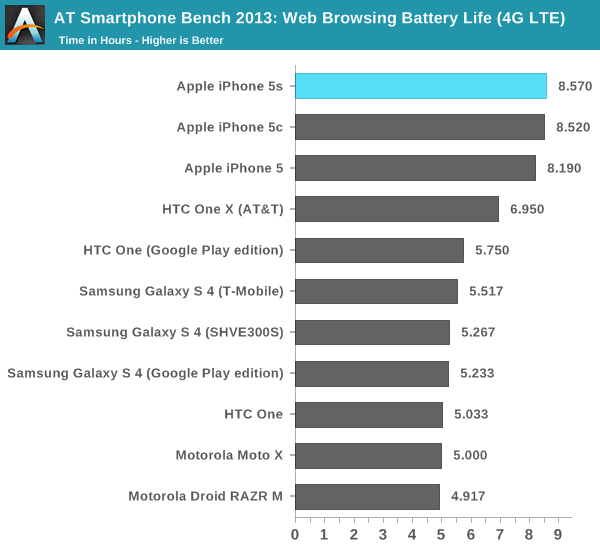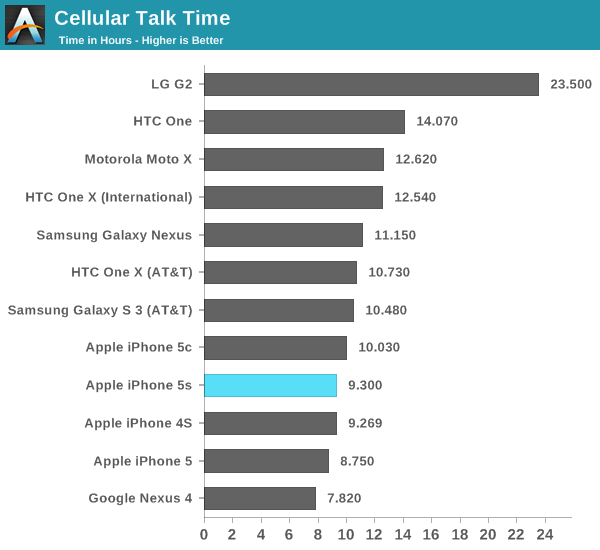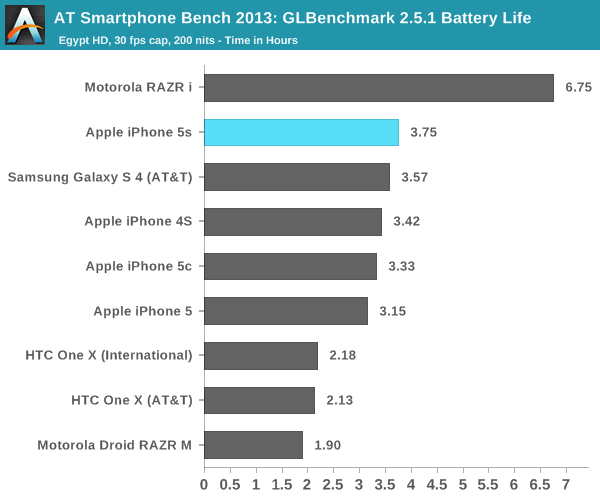The iPhone 5s Review
by Anand Lal Shimpi on September 17, 2013 9:01 PM EST- Posted in
- Smartphones
- Apple
- Mobile
- iPhone
- iPhone 5S
Battery Life
Brian did some excellent sleuthing and came across battery capacities for both the iPhone 5s and 5c in Apple’s FCC disclosures. The iPhone 5 had a 3.8V 5.45Wh battery, while the 5s boosts total capacity to 5.96Wh (an increase of 9.35%). The move to a 28nm process doesn’t come with all of the benefits of a full node shrink, and it’s likely not enough to completely offset the higher potential power draw of a much beefier SoC. Apple claims the same or better battery life on the 5s compared to the iPhone 5, in practice the answer is a bit more complicated.
Unlike previous designs, we’ve never had a half node shrink for an s-SKU. Both the iPhone 3GS and iPhone 4S stayed on the same process node as their predecessor and drove up performance. In the case of the 3GS, the performance gains outweighed their power cost, while in the case of the iPhone 4S we generally saw a regression.
The iPhone 5s improves power consumption by going to 28nm, but turns that savings into increased performance. The SoC also delivers a wider dynamic range of performance than we’ve ever seen from an Apple device. There’s as much CPU power here as the first 11-inch MacBook Air, and more GPU power than an iPad 4.
To find out the balance of power savings vs. additional performance I turned to our current battery life test suite, which we first introduced with the iPhone 5 review last year.
We'll start with our WiFi battery life test. As always, we regularly load web pages at a fixed interval until the battery dies (all displays are calibrated to 200 nits).

The iPhone 5s regresses a bit compared to the 5 in this test (~12% reduction despite the larger battery). We're loading web pages very aggressively here, likely keeping the A7 cores running at their most power hungry state. Even the 5c sees a bit of a regression compared to the 5, which makes me wonder if we're seeing some of the effects of an early iOS 7 release here.
The story on LTE is a bit different. Here we see a slight improvement in battery life compared to the iPhone 5, although the larger battery of the 5s doesn't seem to give it anything other than parity with the 5c:

Our cellular talk time test is almost entirely display and SoC independent, turning it mostly into a battery capacity test:

You can see the close grouping of the smaller iPhones at the bottom of the chart. There's a definite improvement in call time compared to the iPhone 5. We're finally up above iPhone 4S levels there.

Our Egypt HD based 3D battery life test gives us the first indication that Rogue, at least running fairly light code, can be more power efficient than the outgoing 5XT. Obviously the G6430 implemented here can run at fairly high performance levels, so I'm fully expecting peak power consumption to be worse but for more normal workloads there's no regression at all - a very good sign.










464 Comments
View All Comments
ESC2000 - Saturday, September 21, 2013 - link
So inexplicably the air has this great GPU coupled with a crappy screen that limits the GPU's impact. Then on the windows ultrabooks we have generally better screens (at least on the ones that have similar cost to the air) but less good GPUs.akdj - Tuesday, October 8, 2013 - link
Touché. I'll give ya that one. While I do love my MBA for travel, the screens suck! Point was not to compare displays----rather iGPU technology movementvcfan - Wednesday, September 18, 2013 - link
I doubt the A7X is even close to 300GFLOPStipoo - Wednesday, September 18, 2013 - link
78 times 2. It'll probably be close to 160 Gflops, if historical A*X series performance doubling is to be followed.DeciusStrabo - Wednesday, September 18, 2013 - link
Admittedly the original 11" MBA was a dog in terms of performance when it was released. Still 1/3-1/2 (depending on the benchmark) of the speed of my i3-3220 Home Server isn't exactly bad for a phone.jeffkibuule - Wednesday, September 18, 2013 - link
Didn't the original 11" MBA have overheating problems? That thing was a toaster.coolhardware - Tuesday, September 17, 2013 - link
Very nice review as always Anand :-)I especially enjoyed checking out the display closeups and charts. As you mention, Apple's display size and pixel density are both falling behind flagship phones from other manufacturers, this list http://pixensity.com/list/phone/ puts it well outside of the top 10.
However, Apple displays are generally pretty nice to look at. I cannot help but wonder if Apple is going to get any major display breakthroughs in future generations, or if other manufacturers (Samsung, LG, or other) will be able to surpass it... anyhoo, thanks for the nice review!
PS if anyone has subjective opinions after viewing the 5s' display versus other flagships, I would appreciate hearing about it!
Impulses - Tuesday, September 17, 2013 - link
It's not like Apple's designing their display in Cupertino... I'm sure they have a large degree of control in order to get the specs they need and the calibration etc, but if there's any sorta revelation in display tech it'd come from the labs of the people that actually make them (Samsung, LG, Sharp, etc).Impulses - Tuesday, September 17, 2013 - link
Oh and my subjective opinion on current flagship displays is that I'd still take an IPS/super LCD/whatever over the typical over saturated AMOLED, the Moto X made a strong case for using AMOLED for it's active notifications but ehh... I like LG's tap to wake gimmick on their recent models, and after owning two 4.3" devices and a 4.6-4.7" (all with capacitive buttons) I'm actually yearning for something a bit more compact. I think the Moto X is a near perfect fit, although it does sacrifice some screen space for the buttons... I thought on screen buttons were pointless at first because none of the early devices that used them had less bezek space nor where they smaller, but we're finally seeing that become a reality with the X and the G2 so I think I'm on board now. Die bezels die! (along with menu etc, HTC dumping the multi task button bothered me tho, one of their few design missteps IMO)coolhardware - Tuesday, September 17, 2013 - link
Thank you Impulses for the nice analysis.I too really like the Moto X. It seems like it hits the sweet spot in size/capability plus it is actually available on my carrier (US Cellular). I wish that all carriers got the Moto X customization options though because I find that to be a pretty cool feature:-)
I will eventually be replacing my Galaxy Note 2 with giant extended battery:
http://goo.gl/TxUnez
with something and right now it is a toss up between the upcoming Galaxy Note 3 and the Moto X. I really dislike how sluggish my Note 2 can be and I mainly blame that on Samsung's skin on top of Android :-( That is a big plus for the Moto X since I hear it is pretty clean in that respect.
My new choice may be Moto X + Nexus 7 FHD rather than Note 3.
Any other thoughts/opinions on the topic?